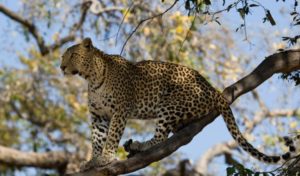Every year on May 3, the world turns its attention to one of nature’s most exquisite and elusive creatures – the leopard – during International Leopard Day. This special day serves not only to celebrate the stunning beauty and incredible adaptability of leopards but also to highlight the urgent need for their conservation

The leopard (Panthera pardus) stands out as one of the five “big cats” in the genus Panthera. This species is renowned for its elusiveness and aesthetic appeal but also for its remarkable adaptability and physical prowess. Leopards are distinguished by their well-muscled bodies, relatively short legs, and long tails, which aid in their excellent balance. An adult leopard is significantly strong, capable of hauling prey much heavier than itself up into the branches of trees. Leopards climb and rest in trees for several strategic reasons.
Trees provide a safe haven from ground predators like lions and hyenas, and allow leopards to store their prey safely away from scavengers. Being elevated also offers leopards a better view for spotting prey and monitoring their surroundings, which aids in hunting. Additionally, trees offer a cooler, shaded environment for resting, especially in hot climates. This behavior not only helps leopards manage their energy and temperature but also serves as a territorial marker to signal their presence to other leopards.
The leopard’s coat is unique with its gold base and dark spots, which help it blend into its surroundings and sneak up on prey. These spots are different from the cheetah’s simple spots or the tiger’s bold stripes, making the leopard’s camouflage very effective in various environments. Depending on where the leopard lives, its coat can vary in color and pattern, helping it hide better and hunt successfully. This special coat is key to the leopard’s ability to live in many different places around the world.
In terms of behaviour, leopards are nocturnal and highly territorial. They use their keen senses of hearing and sight for hunting at night. Each individual leopard has a home range that overlaps with its neighbors, but they actively avoid one another to minimise conflict. These cats are famously versatile, not only in their choice of habitat but also in diet, consuming a range that includes insects, rodents, and large ungulates.
Leopards are divided into nine subspecies, and they have been adapted to survive in various geographic landscapes. Some of these are the African leopard (P. p. pardus) roams the savanna and dense forests of sub-Saharan Africa, while the critically endangered Amur leopard (P. p. orientalis) survives in the temperate forests of Eastern Russia and China. Other subspecies are scattered across regions in Asia and the Middle East, each with adaptations unique to their environments.
Currently, leopards are listed as “Vulnerable” on the IUCN Red List of Threatened Species, though certain subspecies like the Javan and Amur leopards are categorised as “Critically Endangered”. Their numbers have significantly declined due to habitat loss, reduced prey base, conflict with humans, and illegal wildlife trade. In many cultural contexts, leopards are sought after for their beautiful pelts and other body parts used in traditional medicine and rituals.
Recent reports underscore a grim reality: habitat encroachment and poaching continue unabated. In some regions, leopards face retaliatory killings from farmers protecting livestock. Urban expansion has increasingly pushed these adaptable cats into closer quarters with humans, often leading to tragic consequences for both parties.
Various organisations and governments have initiated projects to safeguard the future of leopards. One of the forefront projects is the Leopard Conservation Project in South Africa, which focuses on mitigating human-leopard conflicts and researching leopard populations to inform conservation strategies. Similarly, the Snow Leopard Trust aims to protect this colder climate cousin of the leopard through community-based conservation projects that encourage herder participation.
Technological advancements such as the use of satellite imagery and camera traps are proving invaluable in studying leopard behaviour and tracking their movement patterns. These technologies help in creating effective conservation strategies that include establishing wildlife corridors and protected areas.
As we observe International Leopard Day, let us reflect on the beauty and resilience of the leopard, an animal that has walked the earth for millions of years, yet faces uncertainties about its future. Conservation efforts are in a race against time as each subspecies of leopard navigates a path riddled with threats.
The leopard’s plight reminds us of our broader obligation to preserve the natural world and its inhabitants. By supporting conservation efforts, promoting awareness, and advocating for policies that protect these majestic creatures, we can ensure that the whisper of the leopard’s soft paws will not be silenced in the wilds of our planet.
Let us pledge to be more than passive admirers of their grace and beauty; let us be active participants in their survival stories. After all, preserving leopards is not just about saving an iconic species – it’s about maintaining the health and diversity of ecosystems worldwide. A world with leopards is a world enriched with biodiversity, mystery, and wonder. Let’s keep it that way.
By Assaf Levy, BioDB
